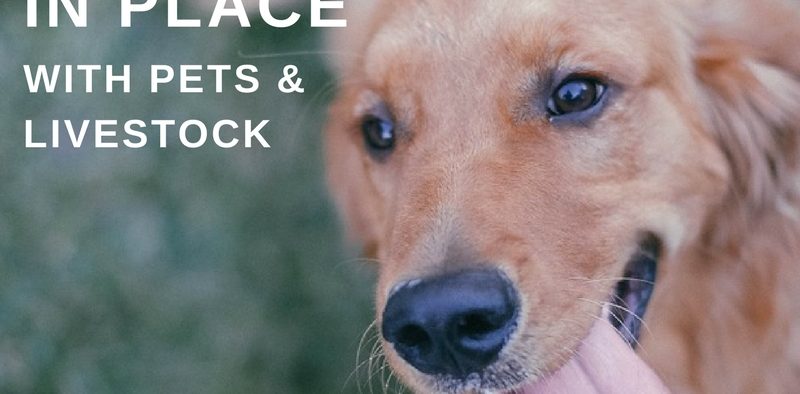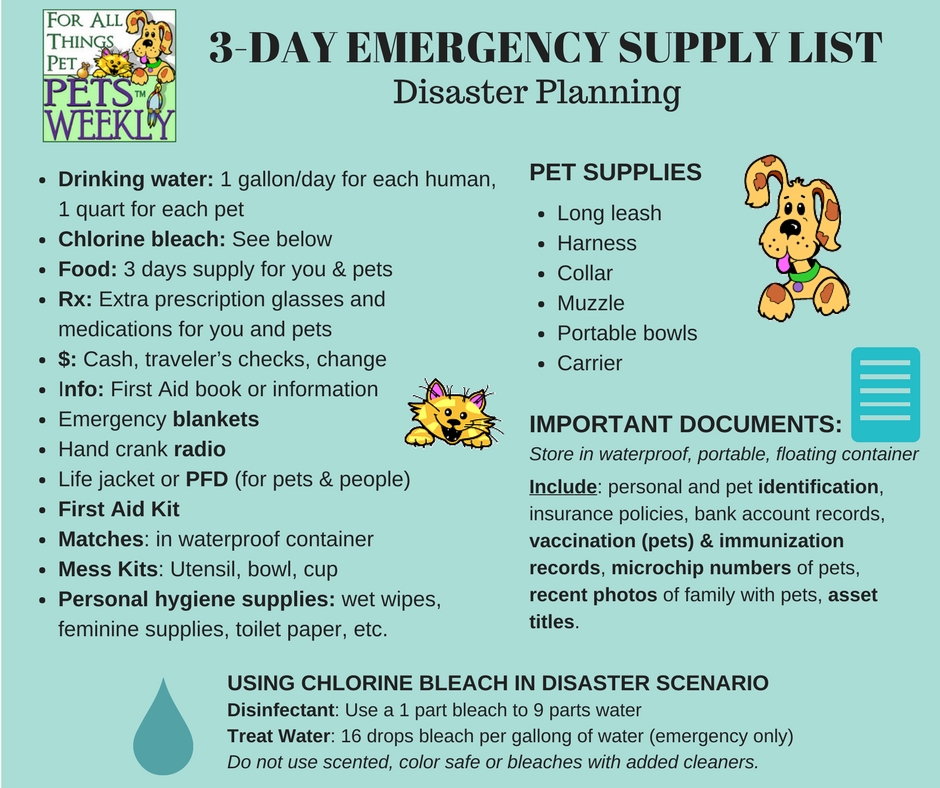Evacuating or Sheltering in Place with Pets in Disasters
Share

The United States and others areas of the world have been faced with disasters everywhere. Massive wild fires decimate the West; the South is still recovering from flooding even while another devastating hurricanes approach; volcanoes erupt in Hawaii, and climate change threatens to flood low-lying areas around the country. With more disasters predicted to be on the way, we want to address a few questions we’ve gotten about your right to evacuate with pets.
After Hurricane Katrina, many people evacuated with their pets, only to be turned away from hotels and shelters for refusing to abandon their pets. This leaves the owners to abandon their pets or venture back into the storm.
NOTE: When possible, we use affiliate links in our posts.
Should I Evacuate with My Pet?
Take your pets with you when you go. Make sure they’re microchipped, carry your vaccination records in a waterproof, floatable container; and make sure they are wearing a collar or harness. You also need to ensure you have a muzzle available to help you gain entry to shelters.
We compiled a list to help you find (and gain) access to transportation, hotels and shelters during any disaster. While we’re focusing this article on Irma, we’ll add resources for fires and other disasters this week.
“Take your pets with you when you go. Make sure they’re microchipped, carry your vaccination records in a waterproof, float-able container; and make sure they are wearing a collar or harness. You will also want to make sure you have a muzzle available to help you gain entry to shelters.”
What Are My Options?
The PETS Act of 2006 was passed to help evacuating owners and pets together. But this doesn’t do a lot for your rights – shelters and hotels can still deny your pets entry.
In fact, all it really did was give the state some extra funds to try and accommodate some pets. This means, they may choose to build extra pet-friendly shelters. They might be able to allow pets on buses, planes and more. There are a few things they can do if they choose, and the feds might help (if you get bored during the storm and you’re looking for some reading, download the policy at this link: – the interesting part starts at page 109)
Let me be very clear: The state has the option to enact pet-friendly transportation and housing if they choose. However, they can deny entry for a number of reasons that include, but are not limited to,:
- pets not being up-to-date on vaccinations
- pets not being microchipped
- pets that are not muzzled (or contained)
- specific breeds of dog they just don’t like
- any species they don’t like (snakes, lizards, cats, rats or more)
- pets they consider to be a threat (this could be a ferret or a pitbull or anything in between)
If you have livestock that must be moved, or know that your pet(s) would not do well in a shelter environment, you may need to shelter in place. You cannot do this without proper planning.
[box title=”Florida Resources for Hurricanes” box_color=”#996633″]- Shelters for People When arriving at a potential shelter, boarding your pet may be required. Place proof of recent vaccinations, photos of your pet and proof of ownership in a water-protected container and have ID and vaccination tags on your pets’ collar.
- The GA, SC, TN, FL & NC ANIMAL RESCUE DISASTER HELP This Facebook group is devoted to helping people with pets during disasters, as well as locating displaced animals and livestock.
- FEMA Evac Hotels: If you are eligible for Transitional Sheltering Assistance, FEMA will pay for the cost to stay in certain hotels or motels for a limited period of time. Costs covered are for the cost of the room and taxes, and any other expenses are not included. Search the list below of participating locations to see if they have availability in the area you have selected. Since room availability changes quickly, please call the hotel prior to travelling to be sure the hotel can accommodate your need.
- Prepare a plan: This .pdf document will help ensure you’re ready in case of emergency.
- Find a pet-friendly hotel: One of our favorite resources is GoPetFriendly – they have the largest updated database of pet-friendly hotels. Some hotels offer “disaster” rates, but there’s generally a waiting list and priority is almost always given to non-pet owners and families.

Temporary Suspension of Rules Moving Livestock in Florida
During Hurricane Irma, Agriculture Commissioner Adam Putnam announced the suspension of rules on moving livestock and pets within the state of Florida.
“By suspending the intrastate movement requirements for the transportation of animals, we can ensure that Floridians and visitors can quickly and safely move their pets and livestock out of harm’s way,” Putnam said in a prepared statement. Also, Putnam said Alabama, Georgia and Mississippi have waived requirements related to moving livestock and pets from Florida.
Learn how to evacuate livestock and poultry in our article, Disaster preparedness with livestock and pets
Sheltering In Place Supply List
Let’s face it – if you haven’t gotten out by now, you will most likely be riding this awful storm out in your home. Here are the ultimate most important things you need right now (if you don’t have them, go get them. Now.).

Drinking water for you and each pet
Water is the one thing no mammal can live without longer than three days. Clean drinking water is mandatory. Neither you nor your pets should drink from contaminated sources of water.
Plan on storage of at least 1 gallon per day per person AND 1 quart per day, per pet. Depending on your climate and emergency situation, you may need more or less than that amount.
Obviously, large dogs and livestock will require more water per day. Read Disaster preparedness with pets for those livestock guidelines.
[/box]AND
A family of two humans and two large dogs should store a minimum of 12 gallons of water for a projected 3-day isolation.
Food: Plan to store a minimum 3-day supply of canned or dehydrated food for each person and pet. Depending on the scenario, you may need to plan for more food and water. We like to make our own meal kits, but there are plenty of pre-packaged kits that is stored in a large bucket (which are excellent for scenarios like this).
Matches: Buy them in a small kit or waterproof by dipping tip into wax and allowing to harden. Store them in a waterproof container. We like that we have flint in the kits.
Knife: A knife is one of the things I”m most grateful for when in any scenario. Choose from Swiss Army knives to large bowie knives. We like smaller, lightweight, multi-purpose tools – but you need to choose according to your environment.
Rx: Be sure to have at least a 3-day supply of prescription medications for you and your pets. If you are being treated for a chronic condition, ask your doctor for a special emergency supply. Don’t forget to pack your prescription glasses.
Important documents: You should have a waterproof, flotable, portable container to carry important documents.
- For people, this includes: insurance policies, personal identification, bank account records, immunization records, copies of prescriptions, and emergency contact numbers.
- For pets, this includes: Vaccination records (critical for getting into boarding facilities or shelters), copies of prescriptions, microchip information, and emergency contact information.
Recent photographs: Identification of your pets can be streamlined if you have recent photos of you and your pet together, as well as photos that show identifiying marks on pets and family.
Money: Cash, traveler’s checks, credit cards and change (for phones, etc).
Emergency reference material: There are many first aid manuals that are portable and waterproof. This is one of our favorites for pets.
Emergency blankets: These thermal blankets are lightweight, easy to carry, and can be used in climates that are hot or cold. They just might save your life.
Rain Poncho: If you are in a hurricane or rainy climate, you will be mighty grateful for these lightweight ponchos.
Sturdy shoes: Before you flee, make sure you are wearing durable shoes. Also, toss in that extra pair of socks – you’d be amazed how great warm, dry feet feel after wading through water for hours.
Life jacket or PFD: Pack one for you and each of your pets. Exhaustion can kick in quickly while swimming and you never know if you’ll be struck by debris and swept into water. Learn about some lifesaving devices at Dogs that can’t Swim and Some that just aren’t very good at it.
Household chlorine bleach: Regular bleach can be used as a disinfectant or emergency water purifier.
- To use as disinfectant (9:1), dilute nine (9) parts water to one (1) part bleach.
- Treat drinking water by adding sixteen (16) drops of liquid bleach per gallon of water. Do not use scented, color safe or bleaches with added cleaners.
Hand crank radio: A hand-crank radio is not reliant on batteries or electricity (recharge by rotating handle). This may be the only way you you can listen to storm updates. Identify local emergency frequencies before storms or emergencies. Choose one with a flashlight – it will save you lots of frustration and will last for years. We like these for any environment.
Personal hygiene items: This includes items like wipes, towels, feminine supplies and other personal hygiene items
Mess kits: This should include (at least) a bowl, spoon (or spork), and an cup. Here’s one we keep in our go-bag (learn more at Preparing Your Pets for Disasters: The Bug-Out Bag)
First aid kit: Keep it small and easy to carry. Read up on what should be included in your kit.

[Learn more about safely camping with pets.]
For Pets
Be sure you have (at minimum), a 3-day minimum supply of the following:
- Water: Plan on storing at least one quart per pet, per day. You can also calculate it by 1 oz * per pound * per day, or 1/1/1. A healthy dog should drink between ½ and 1 ounce of water per pound of body weight each day. Check out How Much Water Does Your Pet Need? for further explanation.
- Food: Dehydrated or canned is best. We prefer to carry sample packs from The Honest Kitchen since they’re prepackaged individually and are lightweight. Also, that’s what we feed our pets anyway, so we can keep digestive upset to a minimum.
- Portable Bowls: Choose one that folds flat and has an attached carabiner for easy carrying.
- Carrier: For cats, you should have carriers on hand at all times nad they should be familiar with them. Learn how to train your cat to love being in a carrier!
- Collar: This is required during a disaster. Please keep a collar on your pet at all times.
- Leash: We like this long leash for hands-free walking. If you have a larger dog, consider having them carry their own supplies. Learn how at Why Your Dog May Need A Job – it can help minimize your stress (and their stress) and take a load off of you.
- Harness: Ultimately, harnesses are the best way to control your pets in any type of situation, particularly if you’re planning to seek public shelter.
- Basket Muzzle: You really need to have a basket muzzle available for each of your pets. We are not fans of muzzles, but it makes others feel better about letting your pets in a shelter environment. Choose a basket muzzle that allows plenty of breathing room and allows the dog to drink, eat and open their mouth normally (our preference is for the Baskerville Basket Muzzle).
- Important documents: This includes your pets’ Microchip numbers, vaccination records, and recent photos of you with your pets. These can be laminated and carried with you or added to the cloud where you can access them via your phone or computer.
Survival is about working together for a successful outcome. Do your part by making sure your pets won’t increase fear or pose a new threat to those with whom you are seeking shelter.










